ELECTROMAGNETIC AND
RESISTIVITY
MODELING
BACKGROUND
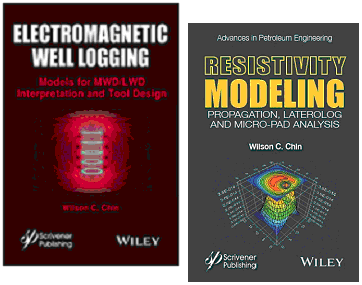
Peruse any journal or conference article, and you'll find terms like Born approximation, integral equation method, dipole model or method of moments. Well known approximations which only attest to the difficulty of general three-dimensional electromagnetic problems. Then, of course, there are the requisite "validations" - more often than not, fortuitous oilfield discoveries and log examples which have little to do with solving Maxwell's equations correctly.
Our books Electromagnetic Well Logging and Resistivity Modeling from John Wiley & Sons develop carefully validated, mathematically rigorous methods focused on petroleum exploration applications. Three-dimensional and axisymmetric alternating current models are discussed, as are direct current methods with respect to laterolog and pad resistivity design. Anisotropic predictions for Rh and Rv also form focal points for discussion. As shown below, our coil points and layer interfaces are coincident with mesh node locations, thus avoiding random noise effects associated with one company's use of "staircase grids."
TECHNOLOGY
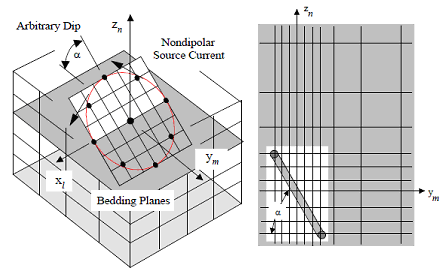
Our flagship solver addresses three-dimensional electromagnetic simulation assuming large coils oriented arbitrarily in layered, anisotropic and heterogeneous media. In fact, transmitters need not be circular nor closed. Similarly, receiving antennas may be coiled, elliptical or open, or custom designed by the user. Induced voltages are calculated, not from "canned formulas" which assume small loops, but general "E dot dL" line integrals.
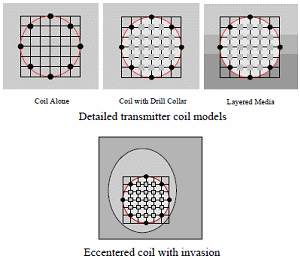
Consider, for illustrative purposes, circular transmitter coils. As shown above, eight current sources are used to represent (red) coils of any diameter. Current magnitudes and orientations are assigned at each node, in a "vector potential" formulation for A that allows direct electrical source excitation. This approach, as noted by Nobel Laureate Richard Feynman, provides greater flexibility than B and E formulations for antenna design and evaluation.
Our transmitters can reside across multiple layers at any orientation. Points within the loop are characterized by formation or fiberglass properties (for wireline applications) or metal characteristics to represent MWD drill collars (often, we set A= 0 directly for more rapid convergence). Extremely rapid and stable matrix solvers are used to invert systems of 2nd order accurate finite difference equations. On completion, solutions for electric, magnetic, vector and scalar potential fields are tabulated and automatically plotted using integrated color graphics.
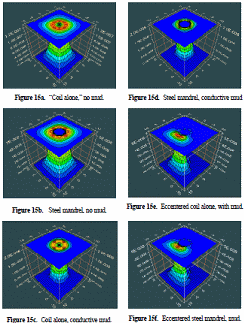
For instance, the above electric field outputs for a "coil antenna alone," with and without conductive mud, and with and without steel mandrel, were completed within five minutes of computing time on standard Windows machines without accelerator boards. The complete work session itself, from start to finish, required about thirty minutes.
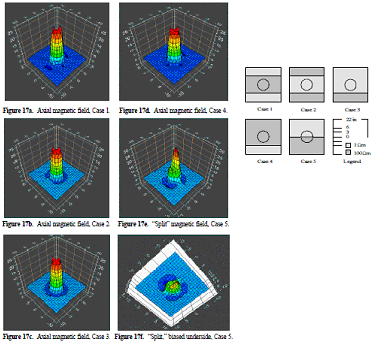
A second example shows axial magnetic fields obtained for a circular transmitter occupying different positions in the cross-section of a layered geology. One exceptionally difficult case is shown with the coil residing across two layers with highly contrasting conductivities. Examples such as these are routinely and easily solved using the new approach. Our book Electromagnetic Well Logging provides additional difficult examples and addresses inverse applications where Rh and Rv are sought when data from multiple receiver coils are available.
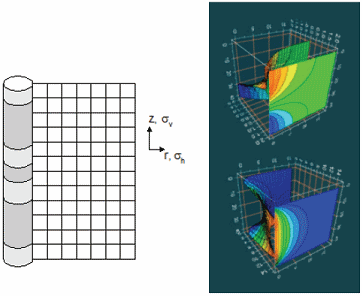
In Resistivity Modeling we also consider (in addition to A/C models) direct current applications, e.g., as are encountered in laterolog and pad resistivity tool design and data interpretation. Special emphasis is placed on formation anisotropy, an important property generally ignored in the industry. Service company publications typically show current lines as orthogonal to lines having constant voltage - a situation true only for isotropic problems, and then, only in planar limits. We have developed exact methods for tools with arbitrary diameters in formations with general Rh and Rv values. These are necessary because electromagnetic and resistivity tools respond differently in horizontal versus vertical wells when anisotropy is significant. These issues are carefully covered in both books, where math models and algorithms are given in their entirety.
About Us
Home | Team Members | Papers | Patents | Books | Brochures | Contact |
Research, Science and Engineering
Home | Measurement While Drilling | Formation Testing | Fluid Rheology | Managed Pressure Drilling | Reservoir Engineering | Electromagnetic Modeling | Waves and Vibrations | Aerodynamics | Biomedical Imaging |
Copyright (C) 2025, by Stratamagnetic Software, LLC. All rights reserved.